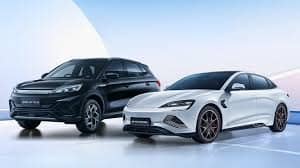
BYD, the Chinese electric vehicle (EV) giant, has introduced a groundbreaking advancement in EV technology with its new “Super e-Platform,” featuring megawatt fast-charging systems. Announced in March 2025, this system promises to deliver up to 400 kilometers (approximately 249 miles) of range in just five minutes, a charging speed that rivals the time it takes to refuel a traditional gasoline vehicle. This development marks a significant step forward in addressing one of the primary barriers to EV adoption: charging time.
The Super e-Platform operates on a 1,000-volt (often rounded to 1 kV in marketing) architecture, utilizing a lithium-iron-phosphate (LFP) battery known as the Blade 2.0. This battery supports a 10C charging rate, meaning it can theoretically charge to full capacity in one-tenth of an hour (six minutes), though real-world results show 400 km in five minutes. The system achieves a peak charging power of 1,000 kilowatts (1 MW), enabled by a combination of high-voltage infrastructure, advanced silicon carbide power chips, and an “all liquid-cooled megawatt flash-charging terminal system” to manage heat efficiently. This is a leap beyond competitors like Tesla, whose latest Superchargers offer up to 500 kW, adding around 270 km of range in 15 minutes.
BYD claims this technology delivers 2 kilometers of range per second during charging, a figure demonstrated during live tests with models like the Han L sedan and Tang L SUV, set to launch in April 2025 in China. These vehicles, priced starting at around USD 37,000, will be the first to utilize this platform. However, the quoted 400 km range is based on the optimistic Chinese CLTC test cycle, which often overestimates real-world performance by about 35% compared to stricter standards like the EPA. Adjusted estimates suggest a more realistic 160–280 miles (257–451 km), depending on conditions, which is still impressive for such a short charge time.
To support this technology, BYD plans to roll out over 4,000 megawatt charging stations across China, with the first batch of approximately 500 expected to be operational by early April 2025. These stations will require significant grid upgrades and include energy storage units to handle the massive power draw, potentially increasing costs. While this rollout is currently China-focused, it showcases BYD’s ambition to lead the global EV market, where it already outpaces Tesla in sales volume.
The implications are substantial: charging times comparable to refueling could eliminate “range anxiety” for many drivers, though challenges remain. The infrastructure demands are steep, and widespread adoption outside China may be slowed by tariffs (e.g., 100% in the U.S.) and the need for compatible high-voltage vehicle systems. Still, BYD’s megawatt charging sets a new benchmark, pushing the EV industry closer to parity with internal combustion engines and intensifying competition for companies like Tesla.
By BHARAT GLOBAL TIME





